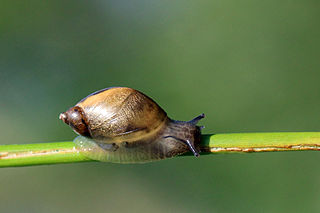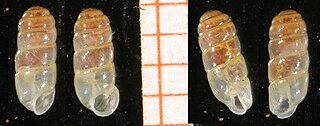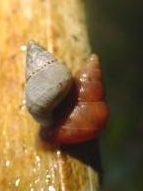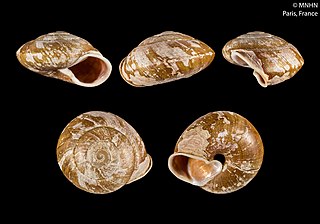
Placostylus, or flax snails, are a genus of very large, air-breathing land snails, terrestrial pulmonate gastropod molluscs in the family Bothriembryontidae.

Succinea, common name the amber snails, is a large genus of small, air-breathing land snails, terrestrial pulmonate gastropod molluscs in the family Succineidae.

Sitala is a genus of air-breathing land snails, terrestrial pulmonate gastropod mollusks in the subfamily Durgellinae of the family Helicarionidae.

Ampelita is a genus of air-breathing land snails, terrestrial pulmonate gastropod mollusks in the family Acavidae.

Edentulina is a genus of air-breathing land snails, terrestrial pulmonate gastropod molluscs in the family Streptaxidae.

Gulella is a genus of very small air-breathing land snails, terrestrial pulmonate gastropod mollusks in the family Streptaxidae.

Omphalotropis is a genus of minute salt marsh snails with an operculum, terrestrial gastropod mollusks in the subfamily Omphalotropidinae of the family Assimineidae.

Rachis is a genus of air-breathing land snails, terrestrial pulmonate gastropod molluscs in the family Cerastidae.

Streptostyla is a genus of predatory, air-breathing land snails, terrestrial pulmonate gastropod molluscs in the subfamily Streptostylinae of the family Spiraxidae.

Subulina is a genus of small tropical air-breathing land snails, terrestrial pulmonate gastropod mollusks in the family Achatinidae.

Tropidophora is a genus of land snails with an operculum, terrestrial gastropod mollusks in the family Pomatiidae.

Leucotaenius is a genus of tropical air-breathing land snails, terrestrial pulmonate gastropod mollusks in the family Clavatoridae.

Kalidos is a genus of air-breathing land snail, a terrestrial pulmonate gastropod mollusk in the subfamily Helicarioninae of the family Helicarionidae.

Voluta is a genus of medium to large sea snails, marine gastropod molluscs in the family Volutidae, the volutes.

Isomeria is a genus of air-breathing land snails, terrestrial pulmonate gastropod mollusks in the family Labyrinthidae.

Xesta is a genus of air-breathing land snails, terrestrial pulmonate gastropod mollusks in the subfamily Ariophantinae of the family Ariophantidae.

Microcystis is a genus of small air-breathing land snails, terrestrial pulmonate gastropod mollusks in the subfamily Microcystinae in the family Euconulidae, the hive snails.

Pedipes is a genus of small air-breathing snails, pulmonate gastropod mollusks in the subfamily Pedipedinae of the family Ellobiidae.

Acroptychia is a taxonomic genus of small to large tropical land snails with an operculum, terrestrial gastropod mollusks in the family Cyclophoridae.



















